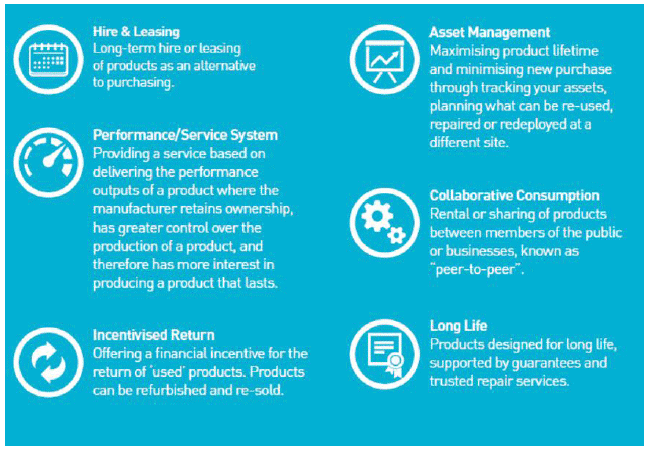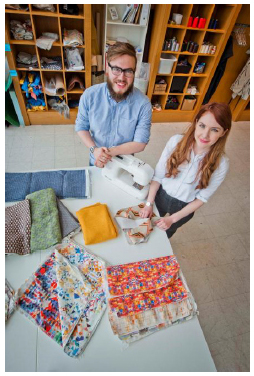Making Things Last: a circular economy strategy for Scotland
Our circular economy strategy to build a strong economy, protect our resources and support the environment.
2. Design
2.1 Our ambition
We want Scotland to be at the forefront of design for a more circular economy, combining ambitious research and thinking with practical application. We want to see more Scottish products designed with their full life-cycle in mind: for long lifetimes, ready to be disassembled and repaired, and eventually recycled. And we want an increasing number of companies to redesign their business approaches to find profitable ways to keep hold of valuable products and components: increasing revenue through leasing, servicing, repair and re-sale.
2.2 Context
Action on a more circular economy and to prevent waste starts with design: the design of products, the design of business models, the design of services, and the design of processes.
The design of products is key in determining how far their value can be retained in a more circular approach. Design for disassembly, using standard components, recyclable materials and so on are fundamental to enabling greater repair, reuse, remanufacturing and recycling.
The design of systems and business models shapes the scope for business to retain the value in the products and materials that flow through their operations. Circular economy business models involve hiring and leasing, performance/service systems, incentivised return, asset management, collaborative consumption and long life as set out in the diagram below.
Circular economy business models

Scotland has a strong history of innovation, and a number of sectors and individual companies have already embraced circular economy principles in product design and system design. We now need to raise wider business awareness of circular economy opportunities, particularly innovation in design and we have concluded that the best way to do that is to integrate circular economy thinking, particularly on design, into a more mainstream approach.
2.3 Our priorities
To improve awareness and capabilities around design innovation for the circular economy, we will enhance design innovation support provided through Scottish Enterprise, Highlands and Islands Enterprise and Zero Waste Scotland. This will include a new EU-funded circular economy investment fund and circular economy service through Zero Waste Scotland, and working with Business Gateway. This will be delivered as a coordinated package to companies comprising:
- competitive calls for circular design projects and services including collaborative work between business and academia to catalyse next generation products;
- support for companies in devising and implementing more circular economy business models within their processes and supply chains;
- awareness raising events and case studies showcasing business benefits of product, process and service innovation relating to circular design;
- better connections between innovative companies and Scotland's design community.
To help more businesses take practical steps to adopt more circular practices, the Enterprise Agencies will integrate circular economy thinking within mainstream support for business growth and innovation, working closely with Zero Waste Scotland.
We will work to influence EU decisions on a life-cycle approach to design of products and packaging, with products designed for long lifetimes, ready to be disassembled and repaired, and eventually recycled, for example by restricting the use of toxic materials.
We recognise the potential for public procurement to support the development of a more circular economy in Scotland building on the statutory guidance on the sustainable procurement duty under the Procurement Reform (Scotland) Act 2014 [11] and the extensive training on circular economy principles of the procurement professional community through the Scottish approach to Sustainable Public Procurement.
We will work with public organisations to identify the products and services where innovation and best practice in public procurement can have the greatest benefit in promoting circular approaches such as leasing, repair and remanufacture, while delivering value for money; and how best to expand that best practice, such as through collaborative procurement, guidance or regulation.
Kalopsia: Fashion and textiles professionals share space for sustainability
A new, innovative communal working space and sharing facility in Edinburgh's Ocean Terminal is helping fashion and textiles professionals work sustainably. Zero Waste Scotland supported the launch of The Facility, a place where students, graduates and start-up companies can work on design and production projects in a shared space.
The space, run by creative textiles agency Kalopsia, makes available equipment such as knitting and sewing machines, mannequins and CAD embroiderers. People who use the space also have access to trained technicians, and Kalopsia's micro-manufacturing and prototyping services.
Zero Waste Scotland helped develop and implement this circular economy business model. It moves away from the traditional make-use-dispose approach to goods towards methods of keeping them in high value use for as long as possible.
"With The Facility we hope to build a community of textiles related businesses and individuals who can come together to strengthen our industry and promote the benefits of the circular economy," says Adam Robertson, managing director, Kalopsia. "We hope that the circular economy business models developed here will become the new standard for the textiles industry across Scotland and the UK."

Contact
There is a problem
Thanks for your feedback